
| myArmoury.com is now completely member-supported. Please contribute to our efforts with a donation. Your donations will go towards updating our site, modernizing it, and keeping it viable long-term.
Last 10 Donors: Daniel Sullivan, Anonymous, Chad Arnow, Jonathan Dean, M. Oroszlany, Sam Arwas, Barry C. Hutchins, Dan Kary, Oskar Gessler, Dave Tonge (View All Donors) |
| Author |
Message |
|
Tyler C.
|
 Posted: Tue 19 May, 2020 10:42 pm Post subject: Help With Sword Blade ID Posted: Tue 19 May, 2020 10:42 pm Post subject: Help With Sword Blade ID |
 |
|
Hi all,
A while back, a friend of mine picked up a couple of swords from a European antique dealer. Both swords were described as 19th century reproductions. I recently had a chance to have a look at them and handle them. I have developed some of my own ideas which I will share, and which I would love some addition input on as both he and I are interested to know more about these if there is anything that can be discovered. luckily he agreed to let me share some pictures and details here.
I'll start with the larger of the two. Here are a few stats:
Weight: 1075g (2lbs 6oz)
Total length: 1070mm (42.125in)
Blade length: 908mm (35.75in)
POB (from guard): 117mm (4.625in)
This first thing that I noticed about this blade is that it felt good in the hand. Nice and lively with a good shape and non-linear distal taper. The blade seems to be properly heat treated just based on a quick flex test (risky I know). It appears to be older than the fittings and has some notches in the edge that also have the same patina and wear. From my observations I would feel quite comfortable saying that this is a real sword blade that has been repurposed for a display piece. Feel free to correct me here if I have missed something. The other part of this riddle that I would love some input on is, if this is a real blade, what type of sword did it come from? I haven't seen many lenticular blades that do not have a fuller of any kind. I know that they existed, but I can put my finger on where I have seen a similar blade and to what period it belonged. I feel like this is an obvious one, but I can't dig up an example. I should also mention that near the guard there is a small mark stamped in each side of the blade. I have been trying to track down a copy of European Makers of Edged Weapons, Their Marks, but I have not been able to land one yet. I wonder if this mark could be tracked down. Anyone have any leads?
Moving to the hilt of the large blade I found it odd that the pommel appears to be artificially aged. It appears that someone has struck the corners of the pommel with a hammer, and you can even see the same patterns in some of the marks as if there was a blemish on the hammer face that was transferred to the pommel in a couple different places. There is also a coating of some kind on the fittings that makes it appear as if it was gilded at one point. This distressing and patina made me scratch my head a little. Were the Victorian era reproducers artificially distressing their pieces in this way, or could this be a more modern fake (hilt only) trying to be a Victorian era reproduction?
Now on to the little guy. Here are a few stats:
Weight: 765g (1lb 10-3/4oz
Total length: 911mm (35.875in)
Blade length: 781mm (30.75in)
POB (from guard): 120mm (4.75in)
Like the other sword, the blade on this one also feels right, and definitely looks older than the hilt and fittings. There are corrosion pits in the blade surface that clearly show grain (see pictures) indicative of steel with fibrous slag inclusions potentially derived from the bloomery smelting process. There are of course other production techniques that would show similar stranding. It also appears to be heat treated again based on the risky flex test. I don't want to jump to conclusions on this one, but I feel it has the potential of being a blade from a much older sword. At the same time, it also has the potential to be a well balanced fake pounded out of wrought iron but the character of the corrosion pits and the fact that it seems to be heat treated steers me away from this idea. There is a mark on this blade too. Just on one side. It is not like any mark I have seen before, and seems like it could have been added later (see pictures).
I have less issues with the antiquing on the hilt of this one. It actually seems to be a rather nicely done hilt.
Please have a look, and feel free to pick my very basic analysis apart. I'm just hoping to learn a few things here, and gain a better idea of what these two could be to share with my friend. Thanks in advance.
 Attachment: 109.89 KB Attachment: 109.89 KB
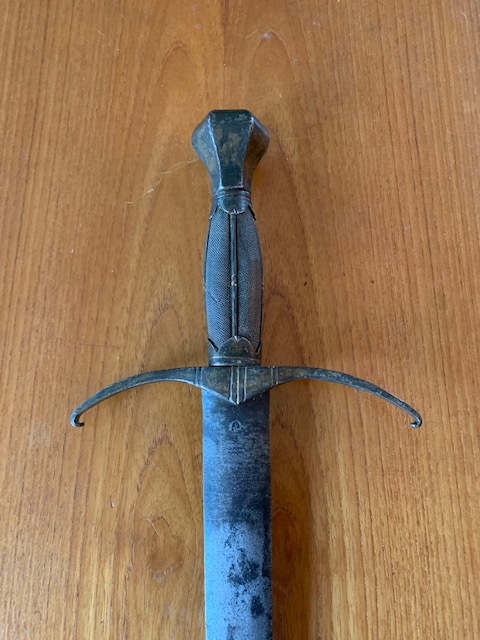
 Attachment: 132.01 KB Attachment: 132.01 KB
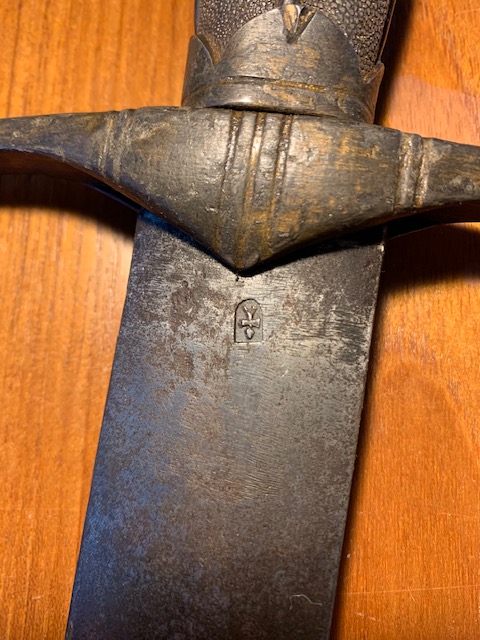
 Attachment: 79.23 KB Attachment: 79.23 KB
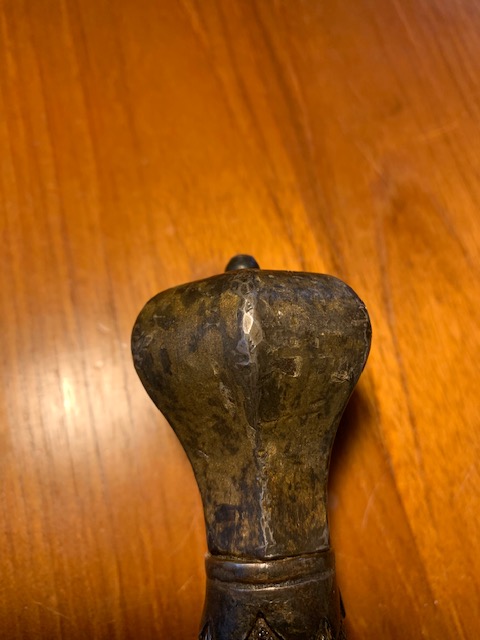
 Attachment: 129.46 KB Attachment: 129.46 KB
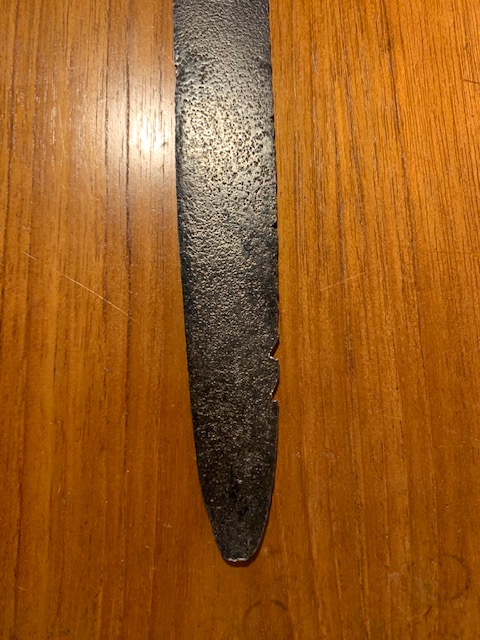
 Attachment: 56.05 KB Attachment: 56.05 KB

 Attachment: 121.4 KB Attachment: 121.4 KB
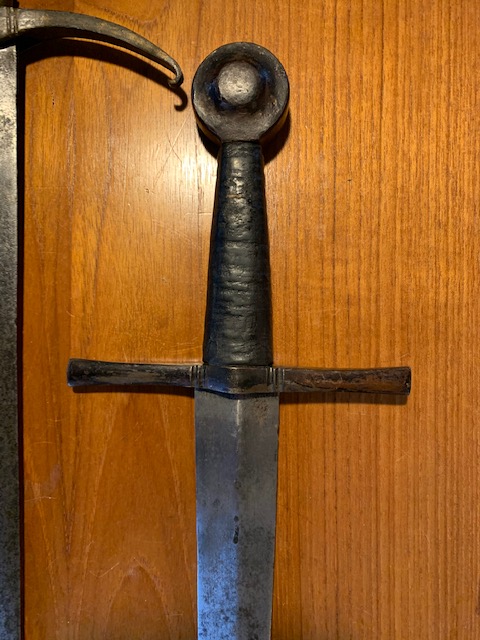
 Attachment: 125.39 KB Attachment: 125.39 KB
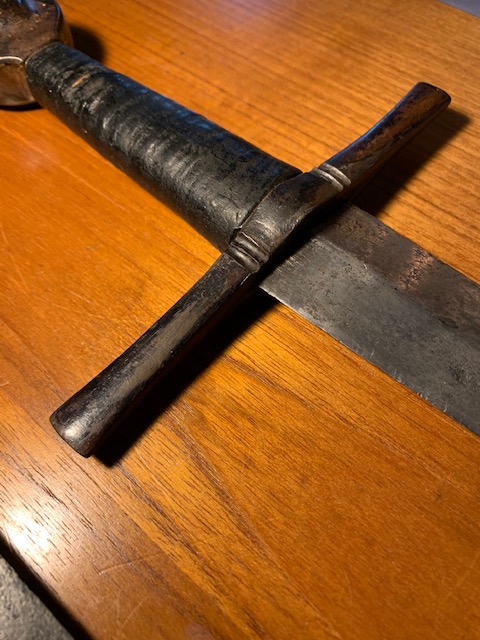
 Attachment: 115.63 KB Attachment: 115.63 KB
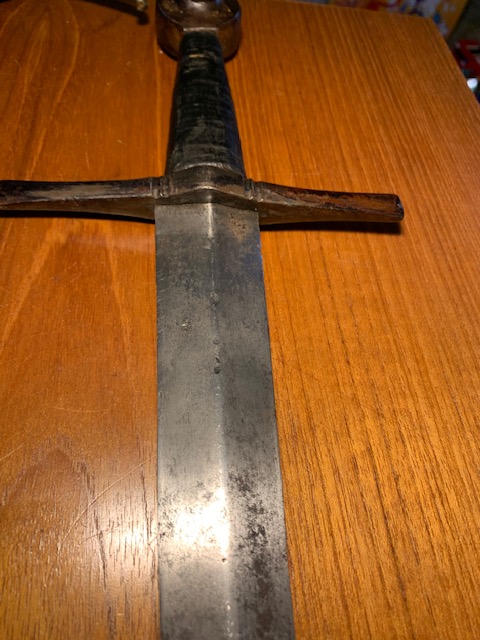
 Attachment: 132.13 KB Attachment: 132.13 KB
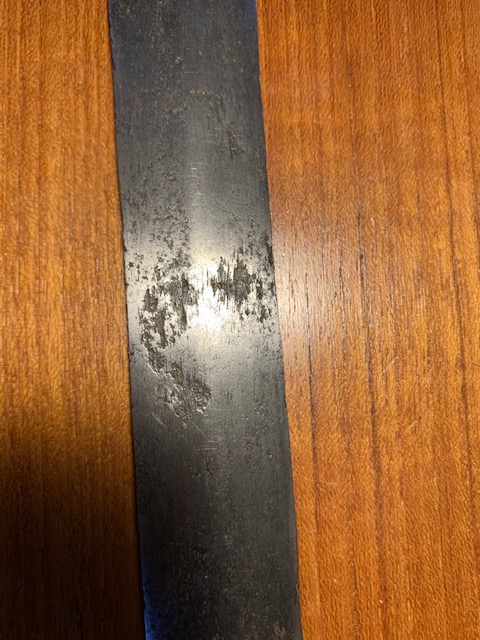
 Attachment: 138.77 KB Attachment: 138.77 KB

|
|
  |
 |
|
Tyler C.
|
 Posted: Tue 26 May, 2020 8:38 pm Post subject: Posted: Tue 26 May, 2020 8:38 pm Post subject: |
 |
|
|
Just wanted to give this one a bit of a bump. Would love to hear any comments. Please don't hesitate to correct me or disagree with anything I have assumed above. I'm here to learn. Thanks.
|
|
  |
 |
|
Tyler C.
|
 Posted: Tue 02 Jun, 2020 5:46 pm Post subject: Posted: Tue 02 Jun, 2020 5:46 pm Post subject: |
 |
|
I have been doing some searching hear and there to see if I can learn more about these and I found a few things that could help place them.
First, I have found a couple ~17th century rapiers like the one below (previously posted on this forum) that have a very similar blade to the larger of the two swords. If the blade above is a Victorian reproduction I can imagine that 17th century blades may have been old enough that they were available for cheap since they were out of date but so old that they were valuable antiques. Completely guessing here. Very open to thoughts and opinions on this.

From: http://myArmoury.com/talk/viewtopic.php?t=132...start=1386
The other thing that I found was this 18th century Scottish Sgian Achles (also posted here), which has a, A mark very similar to the mark on the smaller of the two blades. I'm not saying they are connected in any way, but at least it is an example of a very similar makers mark.

From: https://myArmoury.com/review_ab_sgian.html
Again, I would really appreciate some input of any kind on either of these two blades.
|
|
  |
 |
|
|
You cannot post new topics in this forum
You cannot reply to topics in this forum
You cannot edit your posts in this forum
You cannot delete your posts in this forum
You cannot vote in polls in this forum
You cannot attach files in this forum
You can download files in this forum
|
All contents © Copyright 2003-2024 myArmoury.com — All rights reserved
Discussion forums powered by phpBB © The phpBB Group
Switch to the Basic Low-bandwidth Version of the forum
|

